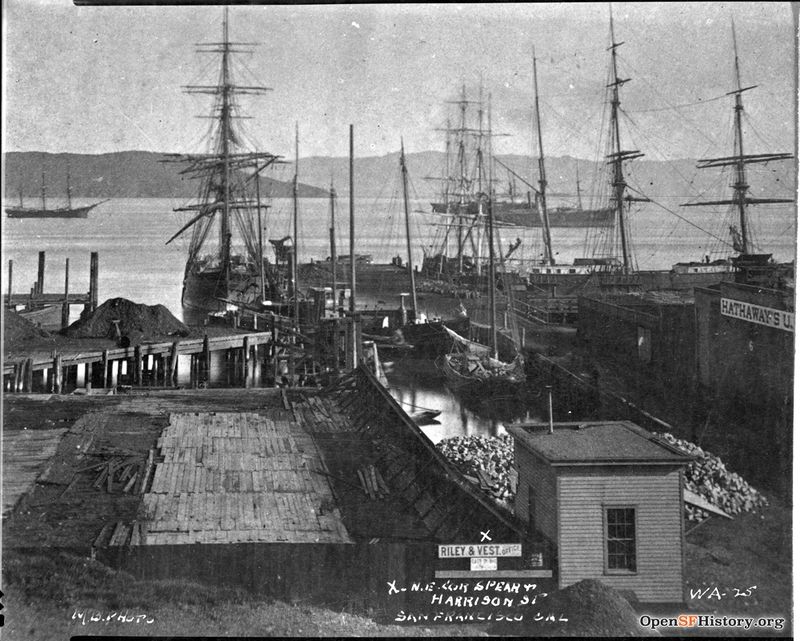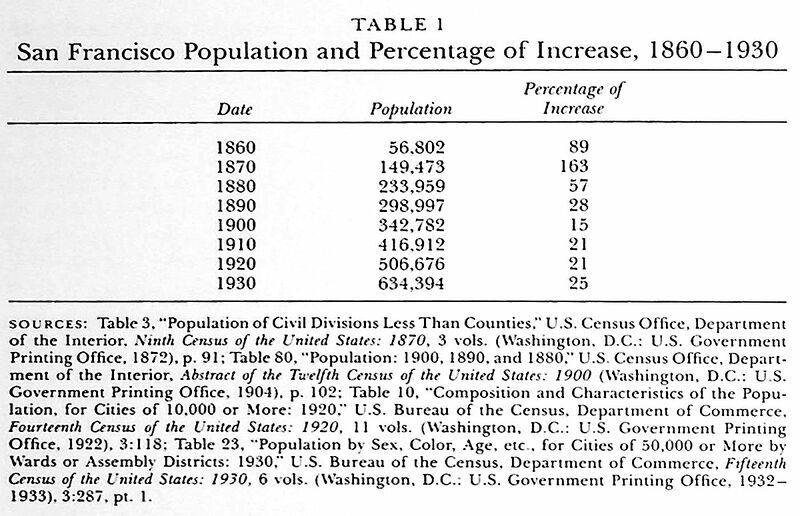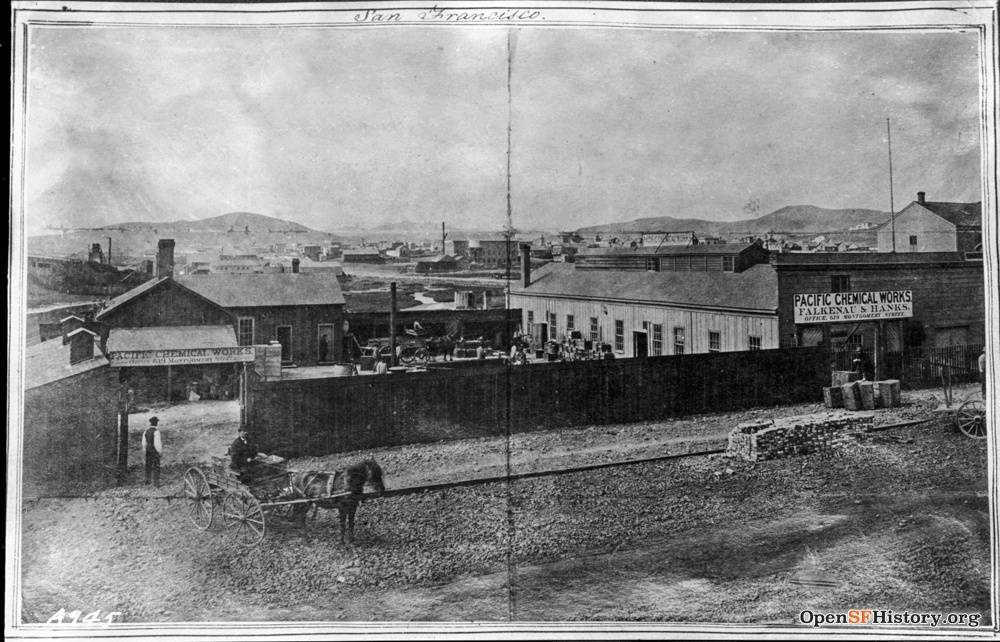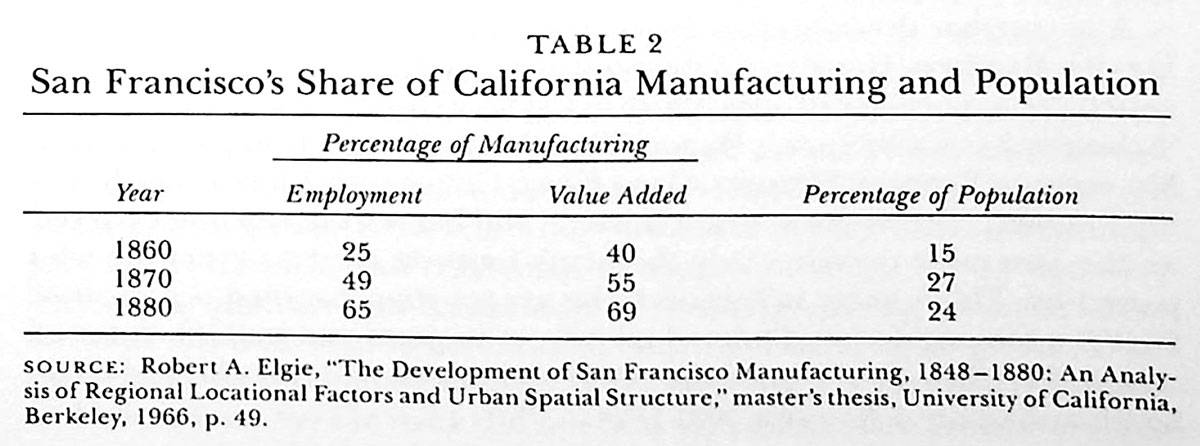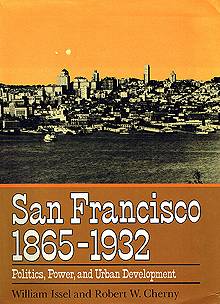Economic Capital of the Pacific Slope
Historical Essay
by William Issel and Robert Cherny
Spear and Harrison, c. 1860s, a couple of decades before the Coast Seamen's Union was founded on a lumber pile near here.
Photo: OpenSFHistory.org wnp71.2174
For thirty years after the discovery of gold, San Francisco stood virtually unchallenged as the economic capital of the Pacific Slope. A recent historian of the urban West describes San Francisco during the 1880s as the “Rome of the Pacific Coast; all roads led to it.” The U.S. Census Office called San Francisco “the commercial metropolis of the Pacific Coast.” Its population growth made it the ninth largest city in the country by 1880 and put it in the eighth rank by 1900. (See Table 1.) San Francisco controlled local trade with Bay Area counties as well as coastal trade from Panama to Alaska. Twenty-one percent of the total population of California, Oregon, and Washington lived in San Francisco, the city’s merchants handled 99 percent of the coast’s imports and 83 percent of its exports, and San Francisco manufacturers produced 60 percent of the region’s goods. Five railroad lines tied the city to its hinterland, and five ferry lines brought commuters from around the bay. The city’s rapid development as an adjunct to the mining business of California and Nevada allowed it to achieve a dominance that made Oakland, San Jose, Stockton, and Sacramento “jewels in San Francisco’s crown” by 1880. The city had more manufacturing establishments, more employees in workshops, greater capitalization, larger value of materials, and higher value of products than all the other twenty-four western cities combined.(1)
San Francisco also led the West as a center of finance. As early as 1868, ten insurance companies operated out of San Francisco headquarters, with about $6 million in capital; thirty-five firms from outside the state operated branches in the city. The Bank of California and the Pacific Bank operated under state charters by the end of the sixties, as did thirteen unincorporated banks, several savings banks, and seven savings and loan institutions. By 1887, the 148 banks in the rest of the state outnumbered San Francisco’s twenty-six banks, but the city had almost twice the assets ($144,368,813) of all other California counties combined ($79,786,557).(2)
San Francisco strengthened its premier position in the region as the decade of the 1880s progressed. The value of foreign imports increased from nearly $40 million in 1886 to over $51 million in 1889. Commerce with other states and territories, overland and sea-borne, came close to $70 million by the early 1890s, and the city ranked fourth in the value of imports and fifth in the value of exports. Only New York, Boston, and Philadelphia (and the latter by only a small margin) topped San Francisco in the value of imports. San Francisco’s export trade fattened on the shipping of wheat and flour, prompting a writer in 1891 to boast that “like a second Egypt we help to feed the nations.” By the nineties the city’s exporters depended primarily on “the products of our own soil, mines, and industrial establishments, so that every increase in quantity and value means a corresponding increase in home industry.”(3)
Pacific Chemical Works at 16th near Mission Creek in 1869.
Photo: OpenSFHistory.org wnp36.03624
Manufacturing also contributed to San Francisco’s economic growth between the 1860s and the 1880s. In the ten years after the gold rush, manufacturing in San Francisco had been “both directly and indirectly the hand maiden of commerce.” By the 1880s, manufacturing had become as important to the city’s economy as trade and commerce, with 41 percent of the growth of employment in the previous decade coming from the increase of manufacturing jobs as compared with only 35 percent from jobs in trade and transportation. The persistence of San Francisco’s relative isolation from the country’s leading manufacturing centers, combined with the gradual lowering of the costs of raw materials and labor, plus the accumulation of local capital, led to the eventual replacement of many imported manufactures by home industries between the 1860s and the 1880s. By then, San Francisco had a “broadly based,” diversified, manufacturing sector.(4) (See Table 2.)
In 1870, the census figures showed the city s value of manufactured goods to be just over $37 million, whereas in 1890 the total came to over $118 million, or about $300 per capita. The number of companies of every size doubled during the period, with greatest growth in very small and very large firms. New firms proliferated, and while over one hundred establishments employed between twenty-five and fifty workers, the typical workshop hired fewer than five hands as late as 1880. Foodstuffs, clothing, textiles, hardware, leather, and provisioning accounted for approximately half of manufacturing employment and about a third of the manufacturing output of the city. By 1890, the processing of foods earned $50 million, fabrication of metals $10 million, leather goods $10.5 million, textiles $13.5 million, lumber $14.5 million, with another $20 million contributed by all other manufacturing.(5)
Eight times out of ten, capital for the development of San Francisco manufacturing during this period came from the profits made by merchandisers or from savings deposited by wage earners. “Practically all of this capital,” according to economic historian Robert Trusk, “was accumulated in California by men who were engaged directly or indirectly with the products they later manufactured.” San Francisco steadily increased its share of California’s manufacturing, suggesting an analogy with the “pattern of development characteristic of many underdeveloped countries today where economic growth is localized in spatially restricted zones.”(6)
The boot and shoe industry, along with the cigar industry, amounted to about $10 million of the total value added by manufacture in 1890, but they, like “every other carried on in the city, [were] cast in the shade by the sugar refining industry.” Something of a local success story, the sugar-refining business (estimated at $17 million in 1890) owed much of its success to the efforts of Claus Spreckels, who as president of the California Sugar Refinery brought a “renaissance” to the business. Spreckels established his first refinery in 1863 at the corner of Brannan and Eighth streets, and by 1884 his huge works in the Potrero District could be described as “the most complete concern of the kind in the world, and in size ranks with the great refineries of Brooklyn, New York, and St. Louis.” One of the three giants that controlled the nation’s sugar business in the nineties, Spreckels's products dominated “the entire trade of the region." No other single manufacturing industry could match sugar refining in value of products, although canned goods were valued at $4 million, beer generated $3.5 million, and coffee and spices earned $I.5 million. Clothing manufacture ($4 million), doors, sashes, and other lumber items ($3 million), and leather goods exclusive of boots and shoes (over $3 million) headed the list.(7)
Fruits, canned, dried and green, salmon and other articles of food figure largely. Wine to drink for the East. Mexico and Central America and the islands of the Pacific, contributes its share. Lumber to build houses in all parts of the world from Australia to Scotland, including our famous redwood. . . . Then come groceries and manufactured goods of every description to the islands of the Pacific Sea.(8)
Notes
1. Lawrence H. Larsen, The Urban West at the End of the Frontier (Lawrence, Kans., 1978), p. 39; U.S. Census Office, Department of the Interior, Report on the Social Statistics of Cities, 2 vols. (Washington, D.C., 1887), 2:804-805; James Bryce, The American Commonwealth, 2 vols. (New York, 1908), 2.428.
2. Titus Fey Cornise, The Natural Wealth of California (San Francisco, 1868), p. 658; Leroy Armstrong and J. O. Denny, Financial California: An Historical Review of the Beginnings and Progress of Banking in the State (San Francisco, 1916), p. 29.
3. Builders of a Great City: San Francisco’s Representative Men (San Francisco, 1891), pp. 57, 82, 58, 86.
4. Robert A. Elgie, “The Development of San Francisco Manufacturing, 1848–1880,’’ master’s thesis, University of California, Berkeley, 1966, pp. 25, 28, 30,49,52,124,127.
5. Neil Larry Shumsky, “Tar Flat and Nob Hill: A Social History of Industrial San Francisco During the 1870s,” Ph.D. dissertation, University of California, Berkeley, 1972, pp. 42, 57.
6. Robert J. Trusk, “Sources of Capital of Early California Manufacturers, 1850–1880,” Ph.D. dissertation, University of Illinois, Urbana, 1960, p. 172.
7. Builders of a Great City, pp. 58, 25, 60, 84.
8. Ibid., p. 58.
Excerpted from San Francisco 1865-1932, Chapter 2 “Business and Economic Development”

